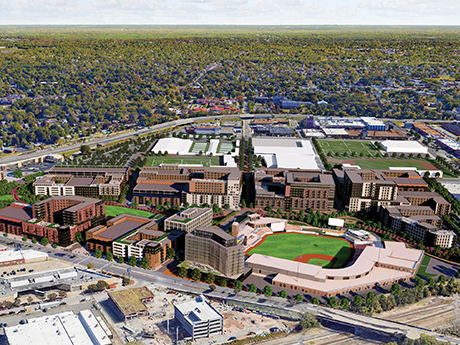Richmond, capital of the Commonwealth of Virginia and centrally located between the rolling hills of the Blue Ridge Mountains and the sandy beaches fronting the Atlantic Ocean, remains a vibrant city with an educated and expanding workforce benefitting from the city’s thriving and diverse economy.
Home to eight Fortune 500 companies and three Fortune 1000 businesses, Richmond’s unemployment rate of 2.8 percent, a 10-basis-point decrease year-over-year, is slightly above the state’s unemployment rate of 2.7 percent but well below the national rate of 4.3 percent, according to data from the U.S. Bureau of Labor Statistics.

Richmond’s job market has remained robust, adding over 38,000 jobs from first-quarter 2020 through summer 2024. In the past 36 months alone, CoStar Group (2,000 new jobs), LEGO (1,760 new jobs), and SanMar (1,000 new jobs) have all announced significant corporate and capital commitments to the market. Government and education/health remain the largest regional employment sectors and have experienced the highest year-over-year employment increases of 3.7 percent and 4.7 percent, respectively.
Richmond’s continued ability to retain and attract talent due to a high quality of life, affordable cost of living and access to an abundance of local and regional amenities has had a profound impact on the area’s multifamily performance in recent years. Strong apartment fundamentals, particularly in the post-pandemic years, clearly position Richmond as one of the top performing markets in the Mid-Atlantic and Southeast.
Many of Richmond’s peer markets are experiencing negative year-over-year rent growth due to weakening demand and abundant supply. The city’s rental gains of 3.4 percent over the past 12 months, while below the five-year average of 5.4 percent, clearly differentiate the MSA from other major regional markets. Leading research outlets anticipate rent growth trends to return to historical averages beginning in 2025 but also below peak levels experienced in the pandemic years.
Richmond’s average monthly rental rate of $1,537 is a relative bargain to other markets and well below many metropolitan areas throughout the country. Rental growth remains strong in all submarkets, particularly in areas like Petersburg/Hopewell with no new development. With reduced supply in the next 24 to 36 months due to rising interest rates, construction costs and stricter lender standards, heightened demand for Richmond will likely lead to stronger growth and elevated rental levels.
Strong absorption and occupancy rates in Richmond also paint a positive light on the market. A recent surge in new development since 2020, spread equally throughout the area with major activity in the Manchester, central business district, Scott’s Addition, Northwest and Southwest Chesterfield submarkets, point to solid renter demand in all pockets of the market.
More than 2,000 units have delivered in Richmond in each of the past five years. While this is seen as unprecedented and teetering on oversupply, this annual figure represents less than 2 percent of the market’s overall multifamily inventory.
Burgeoning neighborhoods in the CBD have experienced the most dramatic growth. Developers and renters alike are drawn to the walkability and proximity to the most trend-setting developments in the area. The Diamond District, for example, is a $2.4 billion development encompassing nearly 70 acres in the city that will incorporate a new Minor League Baseball stadium, 1,700 residential units, hotels and Class A office space.
Surrounding municipalities are also witnessing major growth opportunities. GreenCity, nearby Henrico County’s $2.3 billion eco-district, will feature 2 million square feet of office space, 2,400 housing units, two hotels and a 17,000-seat sports arena. With just under 6,000 units currently under construction in the market, the supply pipeline has been dramatically reduced from the peak level of 2023, indicating a modest slowdown. Demand for Class A product is strong with over 2,200 units being absorbed in the first half of 2024 and outpacing new deliveries.
Overall demand throughout all classes of multifamily product in the Richmond market is solid and consistent with historical averages. Through second-quarter 2024, occupancy levels in Richmond are 94.3 percent and projected to remain above 95 percent for the next four years. All eight submarkets report strong occupancy with only the East Richmond submarket (92.6 percent) reporting a level below 93 percent. According to Globe Street, Richmond was one of only eight major markets in the United States to experience year-over-year occupancy growth in second-quarter 2024.
While apartment fundamentals in Richmond continue to outpace other regional markets, multifamily investment sales in 2024 have remained sluggish. Following peak sale years during the pandemic, transactional volume through the second quarter was well below historic norms. Rising interest rates, tighter lender requirements and a turbulent geo-political environment have all adversely affected property values and resulted in fewer investment sales in the market.
Current headwinds on the sales side will likely transition to a more active position in the fourth quarter of this year and beyond. Richmond enjoys unprecedented positive momentum in population growth, local and regional business practices and overall multifamily fundamentals, all indicators that the city is well-positioned as a leading apartment market and desirable destination for investors in the future.
— By Charles Wentworth, executive managing director of investment sales – multifamily capital markets at Newmark. This article was originally published in the August 2024 issue of Southeast Real Estate Business.


